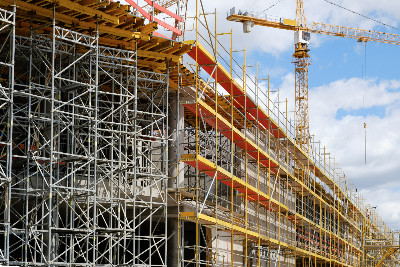You see it everywhere. From small, three-story buildings to massive high-rises, scaffolding  is used for a wide variety of construction, inspection, maintenance and repair projects. According to OSHA, 65 percent of the construction industry, an estimated 2.3 million construction workers, work on scaffolding frequently.
is used for a wide variety of construction, inspection, maintenance and repair projects. According to OSHA, 65 percent of the construction industry, an estimated 2.3 million construction workers, work on scaffolding frequently.
Incidents involving scaffolding account for 4,500 workplace injuries and 50 deaths per year. In addition, scaffolding is consistently among the top 10 most frequently cited OSHA standards violations.
These statistics emphasize the need to construct, assemble and disassemble scaffolding materials safely. ANSI/ASSP A10.8-2019, Scaffolding Safety Requirements, establishes safety requirements for the construction, operation and use of scaffolds used in the construction, alteration, demolition and maintenance of buildings and structures.
Since the original approval of the A10.8 standard in 1969, scaffolding work has evolved considerably as materials, components and technology have changed, allowing for a wider variety of scaffolding options for use on work sites.
That variety is why the standard includes requirements for several different types of scaffolding materials and designs, including platforms, hoisted suspended scaffolds, system scaffolds, tube and coupler scaffolds, and form and carpenter bracket scaffolds. Whichever type of scaffolding is used, ensuring that it will serve its intended purpose and keep workers safe begins in the planning phase.
“Every scaffold should be designed by a qualified person who can perform the analysis needed to ensure that it’s designed properly,” says Dale Lindemer, chair of the A10.8 committee. Lindemer is also chief engineer at BrandSafway.
A10.8 defines a qualified person as “one who, by possession of a recognized degree, certificate or professional standing, or who by extensive knowledge, training or experience has successfully demonstrated the ability to solve or resolve problems relating to the subject matter, the work or the project.”
Beyond having a qualified person overseeing the design, it’s important to closely exam the work site to ensure that workers will be able to do their jobs safely during all phases of scaffolding assembly, use and disassembly.
“You have to look at the building or structure that the scaffolding is going to be erected around and think about what the scaffolding is going to be used for,” says Lindemer. “From there, you have to determine the type of scaffolding that is best-suited to that type of work.”
The best solution for a particular job will depend on factors such as the loads that will be present on work platforms, providing workers with safe access and fall protection, and the number of work levels.
For example, light-duty scaffolding (a maximum load of 25 lbs./sq. ft.) may suffice for work such as inspection and maintenance. On the other hand, if the project involves masonry work and heavy materials such as bricks or blocks, medium-duty scaffolding (a maximum load of 50 lbs./sq. ft.) may be necessary. For even larger equipment or an increased number of workers, heavy-duty scaffolding (a maximum load of 75 lbs./sq. ft.) may be required.
In terms of the type of work being performed, tubular welded frame scaffolding is well-suited for most construction projects due to its easier assembly and disassembly. In industrial settings with piping and obstructions, modular scaffolding generally works better because it can be configured around obstacles and unusual shapes more easily than tubular welded frame scaffolding.
On any work site that requires scaffolding, Lindemer stresses the need for safety professionals and others to keep fall protection in mind.
“Although guardrails are probably the most common form of fall protection, on certain scaffolds, for example single- and two-point suspended scaffolds, you need both a guardrail and a personal fall arrest system,” he says.
Lindemer also advises that passive fall protection, such as a guardrail, is preferable when working on scaffolding so that users will not have to think about their work positioning or where they are tied off, as they would with a personal fall arrest system.
In addition to establishing safety requirements for scaffolding equipment, A10.8 includes training requirements to ensure that workers understand and recognize the hazards associated with working on scaffolding and know the procedures to follow to minimize those hazards.
The standard specifies that employers must provide training for each employee on site-specific hazards and that they understand the correct procedures for erecting, securing, inspecting, maintaining and disassembling the scaffolding systems in use.
For further guidance, A10.8 includes appendixes on conducting a job-site survey and inspecting scaffolding, as well as charts and illustrations on scaffold design.
Listen to our podcast with A10.8 chair Dale Lindemer for further insights on the A10.8 standard and scaffolding safety.
Related Links
Integrated & Automated Systems for Safe Construction Sites
A Consultant's Safety Liabilities A Guide for Working on Multiemployer Sites
Improving Construction Safety: A Team Effort
Fall Prevention on Residential Construction Sites